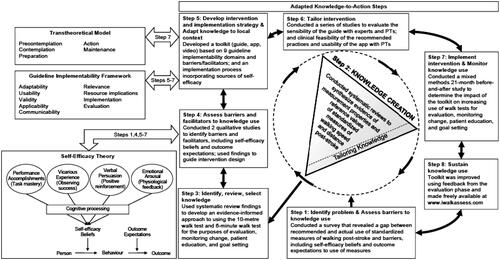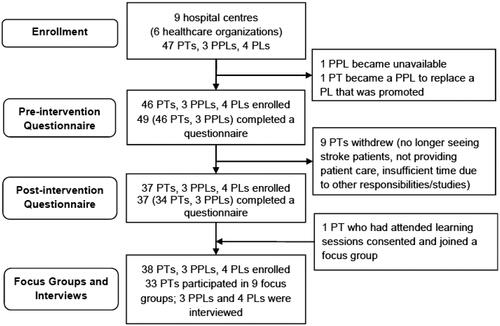Figures & data
Figure 1. Knowledge-to-action framework (taken from Graham et al. [Citation31] with copyright permission).
![Figure 1. Knowledge-to-action framework (taken from Graham et al. [Citation31] with copyright permission).](/cms/asset/ae8e5399-e7af-46df-ab7f-3846e46ee41d/idre_a_1867653_f0001_b.jpg)
Figure 2. Use of the knowledge-to-action framework, self-efficacy theory, a guideline implementability framework, and the transtheoretical model to guide the development and process evaluation of the toolkit and implementation strategy.

Table 1. Purpose and rationale for iWalk toolkit components to address barriers to walk test use.
Table 2. Reviewer ratings of guideline implementability features of the iWalk toolkit.
Figure 3. Overview of data collection for the primary analysis (impact evaluation) and process evaluation.

Table 3. Process evaluation framework: constructs, variables, and data collection approach.
Table 4. Participant and practice characteristics.
Table 5. Completion of learning activities by physical therapists (n = 37).
Table 6. Mobile App Rating Scale scores (n = 31)a.
Table 7. Likelihood of iWalkAssess app improving users’ knowledge, attitudes, intentions, and behaviour (n = 30).
Table 8. Qualitative findings describing iWalk toolkit implementability.
Table 9. Self-efficacy to apply walk test practices pre- and post-intervention (n = 37).
Table 10. Nature of iWalkAssess app use during intervention period (n = 31)a.
Supplementary Material 6
Download MS Word (17.4 KB)Supplementary Material 5
Download MS Word (14.9 KB)Supplementary Material 4
Download MS Word (82.7 KB)Supplementary Material 3
Download MS Word (47.1 KB)Supplementary Material 2
Download PDF (2.6 MB)Supplementary Material 1
Download MS Word (49.8 KB)Data availability statement
The data gathered and used for this analysis are not publically available because of the inclusion of identifying information of the participants and potentially sensitive case information.

